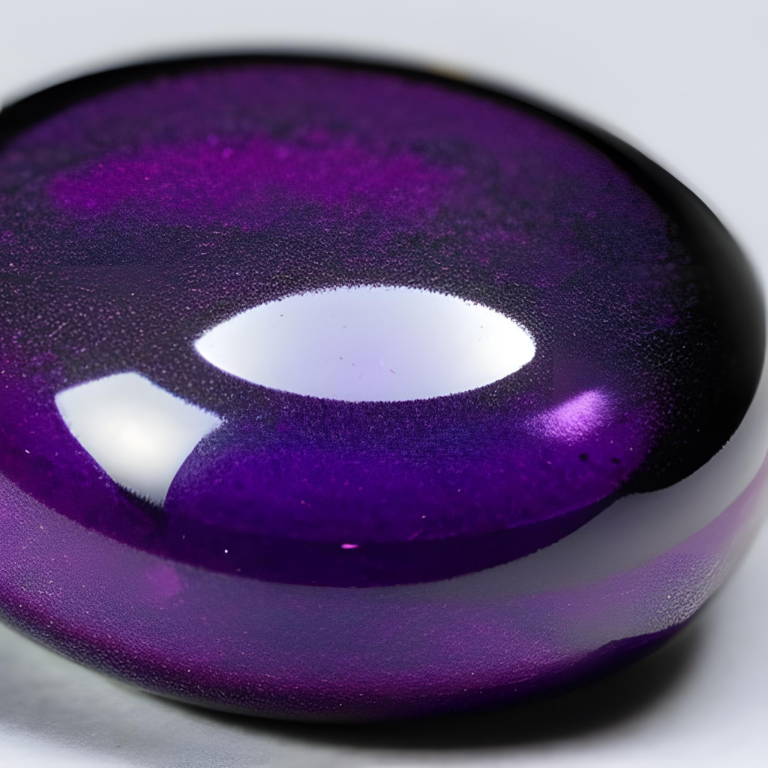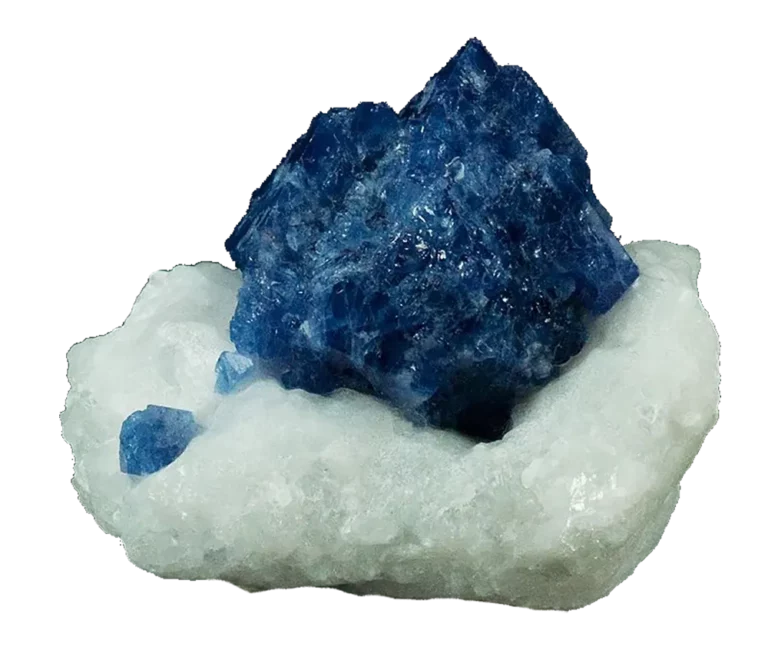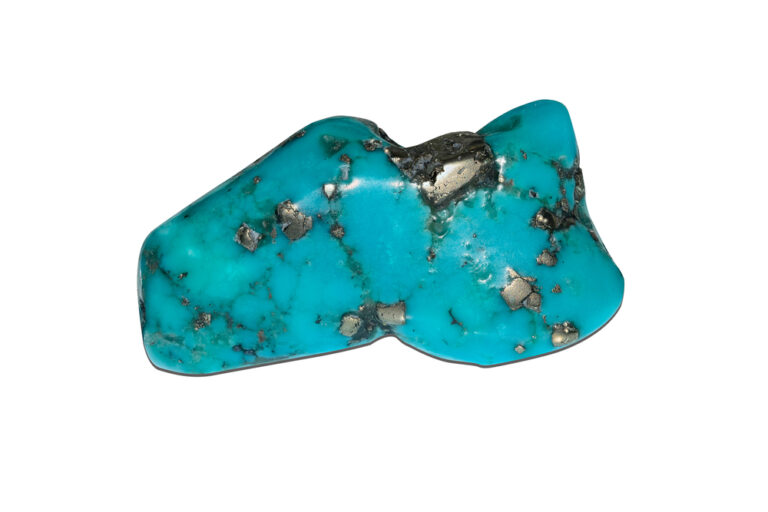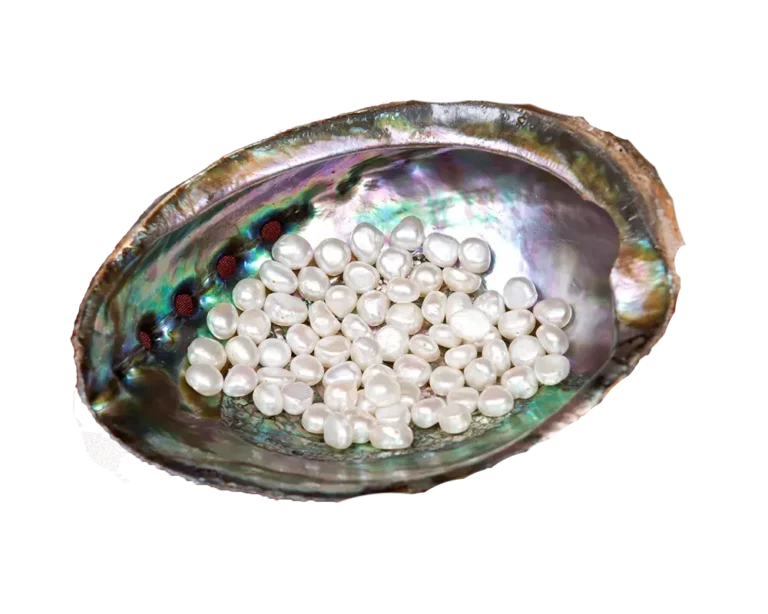Blue Kyanite: Properties, Benefits & Meanings
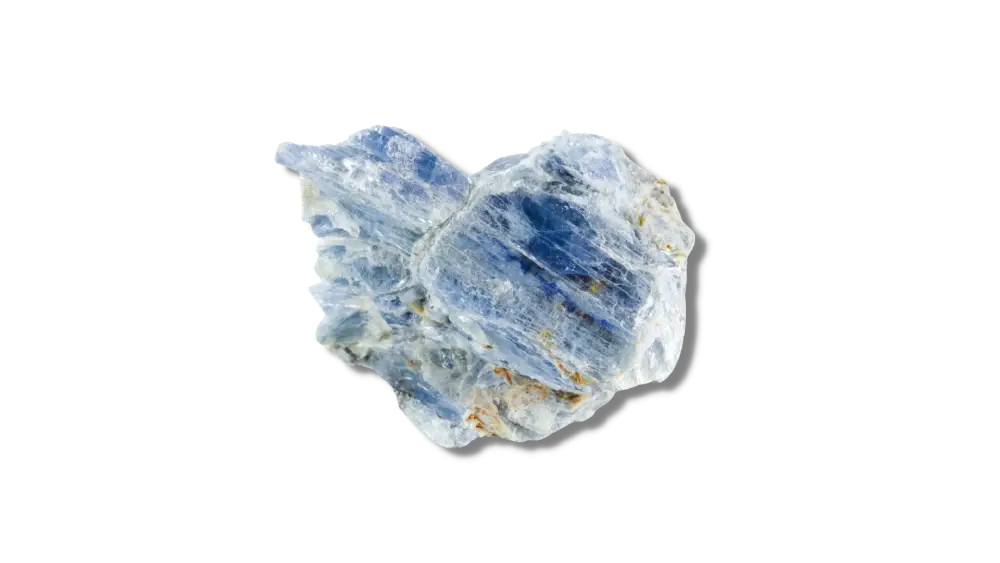
Blue Kyanite Overview
Blue Kyanite is a type of blue feldspar that comes in various colors. It is a very popular gemstone among collectors due to its vibrant blue color.
Its use in Reiki therapy also increases its popularity. Furthermore, this gemstone has been designated as the official state mineral of Virginia since 1987.
This article will talk about the properties, meanings, and uses of Blue Kyanite.
What Is Blue Kyanite?
Blue Kyanite is a semi-precious stone that is deep blue. This beautiful stone is often used by those who practice Reiki and other similar therapies due to its links with the third eye and throat chakras.
Blue kyanite beauty is one of the most sought-after gemstones and is a favorite of many jewelry lovers. This blue crystal comes in a range of colors, but none is as famous and sought after as deep, rich blue.
This stone has a hardness of 4.5 – 7 on the Mohs scale and is also known by several other names, including “Disthene” or “Cyanite”.
Blue Kyanite Appearance
Kyanite is a member of the aluminosilicate mineral class that occurs in prismatic and fibrous forms. It is an unusual and beautiful mineral that was first identified in 1789.
Blue Kyanite has a blue color that ranges from light to deep sapphire. In addition, its pleochroism allows it to change color depending on the angle from which it’s viewed.
Kyanite’s crystal structure and internal crystalline threads produce a bright sparkle unrivaled by any other stone. In addition, it has a vitreous luster, meaning it’s glassy, shiny, and smooth.
Kyanite has elongated and bladed crystals that can be patchy in color.
Kyanite is arguably the most beautiful of all silicate minerals.
The alternate arrangement of its bar-like crystals and strong pleochroism (the property of some substances appearing in different colors when examined at different angles) indicate Kyanite’s complex crystal structure.
Physical Properties
Blue Kyanite, andalusite, and sillimanite are three aluminum silicate minerals having the same chemical composition (Al2O3. SiO2) but differing in physical properties.
Kyanite is anisotropic, meaning it has different physical properties in different directions.
Kyanite is a stone that is generally hard and brittle. This hardness can range from 4 to 7 on the Mohs hardness scale. It has a hardness of 6-7 along the longer axis and a hardness of 4.5-5 along the shorter one.
Blue Kyanite is a metamorphic mineral found in igneous and metamorphic rocks and hydrothermal veins. It is one of the few non-silicate minerals that show an optical property, pleochroism.
| Mineral Group | Kyanite Group |
| Formula | Al2(SiO4)O |
| Color | Blue |
| Hardness (Mohs scale) | 4.5 – 7 |
| Refractive Index | 1.71 – 1.73 |
| Fracture | Splintery |
| Luster | Pearly, Vitreous |
| Specific Gravity | 3.53 – 3.67 |
| Transparency | Transparent, Translucent |
Blue Kyanite vs. Lapis lazuli
Blue Kyanite and Lapis lazuli are blue semi-precious stones with many of the same properties and benefits. However, although their colors are similar, Kyanite is translucent, while Lapiz lazuli is opaque.
Lapis lazuli is a deep blue semi-precious stone famous for its striking color and elegant appearance. Lapis lazuli has been known for thousands of years, with evidence suggesting its use by Mesopotamian civilizations as early as 5,000 B.C.
Unlike most gems, Lapis lazuli is not a mineral at all. Instead, it combines several minerals, such as calcite, lazurite, and pyrite. It has a hardness of 5.0 on the Mohs scale, has a vitreous to greasy luster, and is mainly sourced from Afghanistan.
Kyanite is an aluminum silicate mineral with a vitreous to pearly luster. It is anisotropic with a variable hardness of 4.5-7. Blue kyanite displays trichroic pleochroism and has elongated crystals.
By running a streak test, you can tell the difference between Blue Kyanite and Lapis lazuli. Rub them against a sheet of paper; Lapis lazuli will leave a blue streak, while Blue Kyanite will leave a white or colorless one.
Blue Kyanite vs. Blue Sapphire
Blue Kyanite is a semi-precious stone that is often confused with blue sapphire. Blue sapphire is a precious stone, meaning it’s rare and expensive. However, blue Kyanite is not nearly as expensive as sapphire.
Blue Sapphires are most abundantly found in South East Asian Countries. Most blue sapphires are mined in Thailand, Sri Lanka, Madagascar, and Australia.
Kyanite consists of aluminum silicates formed in layers that can be separated by heat treatment or pressure; this property makes it an excellent candidate for use as gems or ornamental stones.
Sapphire is a type of corundum, which has aluminum and iron in its chemical composition. The blue color we see on sapphires comes from traces of iron and titanium.
Both Kyanite and Sapphires are considered hard stones. However, Sapphires are much harder.
Sapphires have a hardness of 9 on the Mohs scales, making them one of the hardest gemstones in the world. However, they are incredibly durable and a popular choice for jewelry and engagement rings.
Blue Kyanite vs. Sodalite
Blue Kyanite and Sodalite are beautiful blue gemstones, each with a unique energy.
Sodalite is a member of the sodalite group of minerals, which includes lazurite, nosean, and hauyne. Sodalites are often confused with Blue Kyanite because they share a similar color and appearance.
The color of Sodalite ranges from light blue to deep cobalt with flashes of purple. It also tends to be softer than kyanites (5.5-6). Sodalite crystals sometimes have a white streak running through them, which makes them distinguishable from Kyanite. They also display poor cleavage.
While not usually considered gemstones in their own right, Sodalites do have some value when polished and cut into cabochons or other shapes that allow light to pass through them at an angle where their color shows best.
Kyanite has long column-like crystals with a variable hardness of 4.5-7. It has perfect cleavage in 2 directions. Kyanite is not commonly used in jewelry; it has several uses in the automotive and refractory industries.
Sodalite is a prevalent lapidary material that can be used in many ways. It is most commonly used for cabochons or polished stones. It also makes beautiful tumbled stones and slabs, often dyed blue, to give them an even more striking appearance.
Sodalite is found in many towers worldwide, including famous obelisks and historical structures.
Where Can You Find Blue Kyanite?
Blue Kyanite is mined from pegmatites (volcanic rock), dikes, and metamorphosed sediments. Jewelry made with blue kyanite stones is especially popular because it is hard to come by.
It is a very versatile stone found in many places worldwide, including:

How Is It Formed?
Blue Kyanite is formed in the same way as other gemstones. It is created in pegmatites when magma cools and crystallizes over millions of years.
The color of Blue Kyanite comes from the presence of iron and titanium, but these minerals are only sometimes present in the same proportions.
This means there are two types of blue crystals: one with a higher percentage of titanium, which has a deeper tone, and another with less titanium, which has lighter tones.
How To Tell If Blue Kyanite Is Real?
- Look for perfect cleavage in two directions.
- Look for shape and color. Real blue Kyanite will have elongated fibrous crystals.
- Try an acetone test. Acetone dissolves the coating that most fraudulent rocks have on them. If the crystal is unaffected by acetone, it may be real.
- Get an expert opinion.
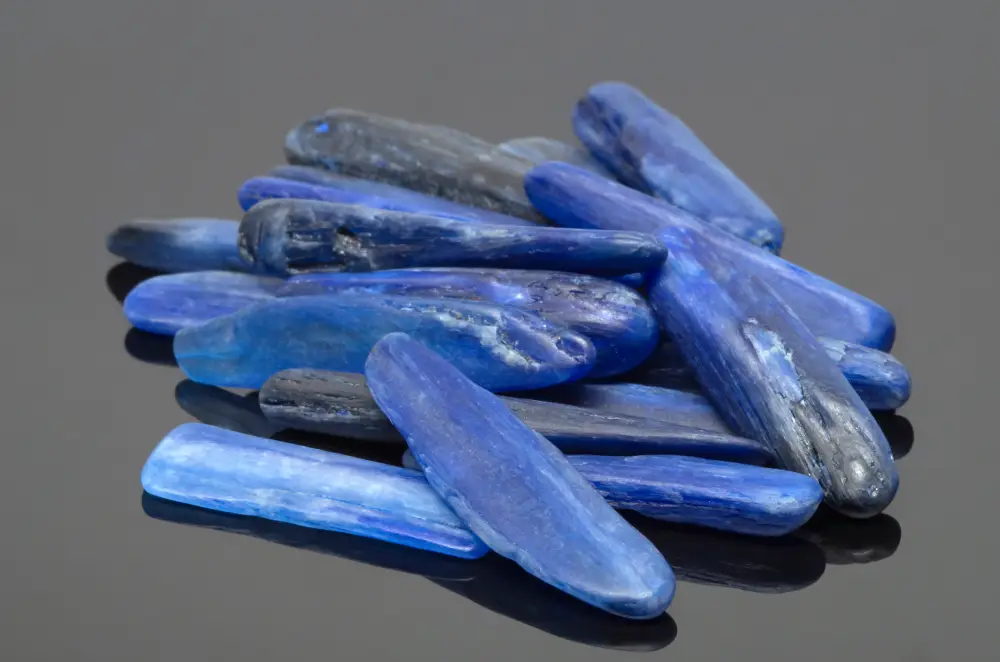
Price & Value
Blue Kyanite is a rare gemstone that many people have never heard of. Blue Kyanite is considered more valuable than green Kyanite and black Kyanite.
Kyanite is a very hard gemstone with a Mohs hardness of 4.5 to 7 on the scale. This means that it is harder than most minerals and can be used for jewelry without being damaged easily.
Blue Kyanite’s price depends on the gemstone’s size, color, and quality.
The price of Blue Kyanite ranges from $60 to $1000 per carat. The price can be even higher if the gemstone is cut in a fancy shape or used as a diamond substitute.
Color: The price is mainly set by the color of the stone. The more vivid and striking the blue color is, the higher the Blue Kyanite value.

Chakra Connection
The Throat Chakra is located in the throat area and relates to communication, self-expression, and creativity. Blue Kyanite works with this chakra to enhance eloquence, clarity, and self-acceptance.
It also helps keep you grounded while communicating your truth with others—a boon for speaking out about injustice or standing up for someone else who needs support.
Blue Kyanite’s radiant energy may help ease feelings of depression and anxiety; it can also encourage joyfulness by helping you feel more connected to the world around you.
Blue Kyanite is also associated with the Third Eye chakra. This chakra is located in the center of your forehead, between and above your eyebrows.
Blue Kyanite works with this chakra to promote clarity, intuition, and creativity. It can help you see things from a new perspective or gain insight into a problem that has been troubling you.
Metaphysical Properties
Blue Kyanite is popular for its metaphysical properties. Allegedly, it can be used for communication and healing and balances yin and yang energy by aligning chakras.
Some say it helps you to be more honest and open in your communications; it allows you to get your point across more clearly. Additionally, it may help you to be more assertive without being aggressive.
Some believe it can help heal problems with the throat, ears, lungs, and thyroid gland by clearing away blockages from these areas of the body.
Blue Kyanite is also believed to cleanse other stones it comes into contact with, making them more powerful and valuable in healing situations.
Blue Kyanite is considered by some to be the stone of cleansing and works well to calm or balance an overactive mind. It is also considered a good stone for dream recall.
It is said that wearing a Blue Kyanite ring releases any negative energy and replaces it with a positive energy flow. It has a calming effect that can help with stress and inner peace.
Meaning and Uses
- Due to its durability and beauty, Blue Kyanite can be used to make jewelry, decor pieces, and ornaments.
- The blue color of Kyanite also makes it popular in the ceramics industry for making vases, bowls, cups, and other items.
- Blue Kyanite is used in construction as bricks, mortar, and insulation.
- It can also be processed into aluminum oxide powder with various uses, including polishing compounds, ferroalloys, welding electrodes, and abrasives.
- Automotive manufacturers have used Kyanite as an abrasive material in their products. When placed near the brake pads on cars with disc brakes (where the car’s wheels stop spinning), this mineral can remove any dust particles that may get caught between them during use.
- Kyanite has also been used as an insulator in high-voltage electrical equipment such as transformers. It doesn’t conduct electricity well when exposed to large currents flowing through wires that carry electric current from one place/object.
- Blue Kyanite is a beautiful crystal for meditation.
- It is a powerful stone often used in feng shui and spiritual work.
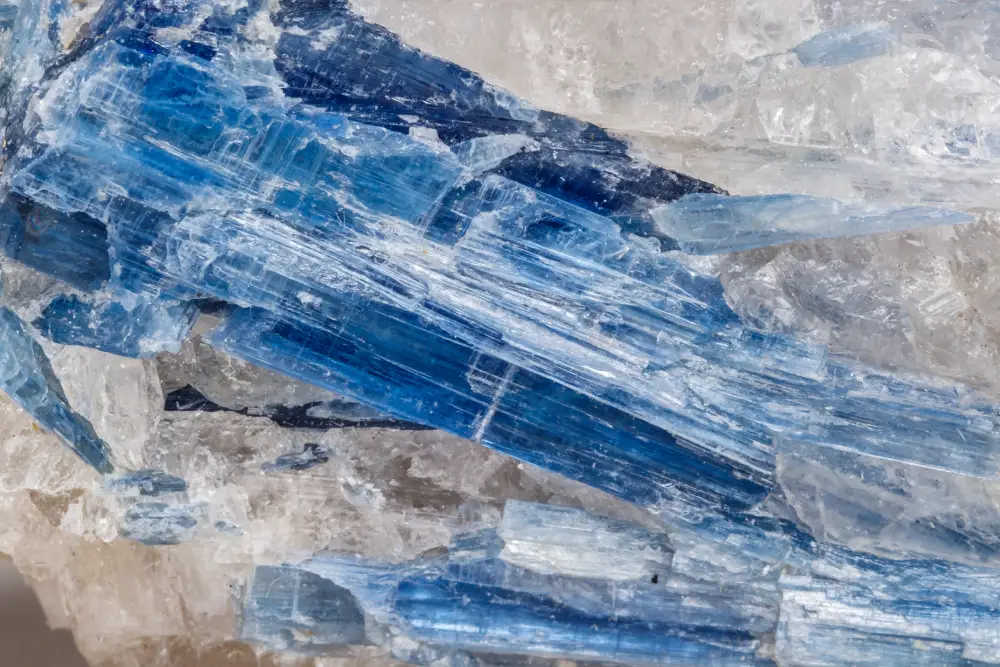
How to keep Blue Kyanite Clean
Blue kyanite jewelry is quite durable, but it does need to be cleaned from time to time.
- Blue Kyanite can be cleaned with soap and water; rub any dirt off and rinse with water.
- Dry using a soft microfibre cloth.
- Use warm water and soap, but never use chemicals or abrasives on your stone.
- Blue Kyanite shouldn’t be heated up (this includes putting it in the dishwasher).
FAQs
What gemstones go well with Blue Kyanite?
Blue Kyanite is an excellent companion gemstone to many other stones. It can be paired with Amethyst, Ruby, Quartz, Aqua Aura Quartz, Blue Sapphire, and Diamond.
What is Blue Kyanite good for?
Blue Kyanite is a high-vibration, crystal-healing stone that relieves stress and energizes the mind. It can be worn as jewelry, used in meditation practice, or placed on an energy grid for cleansing and healing effects.
It can also help you communicate more efficiently with yourself and others. For example, it may prove helpful when you’re trying to communicate with someone who doesn’t seem to be listening to you—it’s like it helps them hear what you are saying, even if they don’t want to attend.
What zodiac is Kyanite?
The sign of Kyanite is Libra. Libra is the scale of balance, and kyanite is one of the minerals with a strong ability to balance energy.
Kyanite is said to assist in balancing yin and yang, or male and female energy within us, along with bringing balance between our physical selves and our spiritual selves. Kyanite is also believed to bring prosperity through business dealings so that all parties involved benefit equally from this interaction.
How do you cleanse Kyanite crystals?
Kyanite crystals are highly sensitive and should be cleansed regularly.
To cleanse Kyanite crystals, you can use sage or smudging. First, place it on a white cloth within your altar as with any crystal treatment. Next, light an incense stick rolled in pure cedar shavings at least six inches from the crystal.
Then place a bit of salt on your fingertips and draw ‘salt circles’ around the crystal two times in both directions. Finally, light the sage stick and cleanse the crystal of any negative energy.
What are the healing properties of Blue Kyanite?
Historically, Blue Kyanite has been considered an excellent stone to use in healing. It is said that the energy of blue Kyanite helps to remove blockages, release confusion and instill a sense of calm in those who wear or carry it with them.
Supposedly, Blue Kyanite is also an excellent aid for those who feel overwhelmed by their thoughts and emotions, helping them manage their world in a more positive light.



